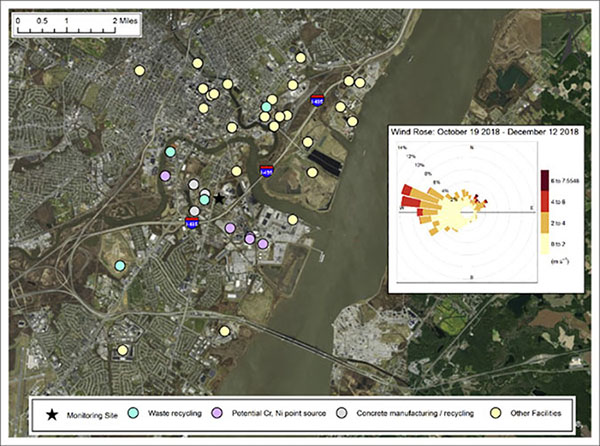Assessment of Particulate Toxic Metals at an Environmental Justice Community
Clients
Delaware Department of Natural Resources and Environmental Control (DNREC)
Sonoma Technology scientists monitored the concentrations and sources of toxic metal and particulate matter concentrations in the community of Eden Park, Delaware, which is ranked highly on the U.S. Environmental Protection Agency's (EPA) Environmental Justice Screen. The results of this study were published in the journal <a href="https://www.sciencedirect.com/science/article/pii/S2590162120300095" target="_blank">Atmospheric Environment: X</a href>.</p>
The abstract of the article is below:</p>
Exposure to particulate matter containing toxic metal species can have negative health implications. The community of Eden Park, Delaware, is surrounded by numerous industrial facilities, the Port of Wilmington, and a highly trafficked freeway, all of which can be sources of toxic metals. The EPA's EJ Screen ranks the community in the 88th percentile nationally for the EJ index of cancer risk and the 90th percentile for the EJ index of PM<sub>2.5</sub> exposure. To understand the ambient concentrations and sources of toxic metals and particulate matter, we collected hourly PM<sub>10</sub> metals measurements using an Xact 625i at a temporary monitoring site in the community. Additionally, PM<sub>2.5</sub>, wind speed and direction, NO<sub>x</sub>, SO<sub>2</sub>, and black carbon were monitored. Conditional bivariate probability function maps and time variation maps were constructed using the OpenAir statistical analysis package, and EPA Positive Matrix Factorization was used to determine the sources of the measured metals. We found that transient concentration events, where arsenic and lead concentrations were more than an order of magnitude larger than the study average, occurred intermittently, but concentrations were generally below health benchmarks. Chromium and nickel had common sources, including a metal plating facility and a chemical additive facility, and unidentified sources were responsible for spikes in chromium levels up to 17 times above average. With Positive Matrix Factorization, three sources were identified: soil/dust, concrete manufacturing dust, and brake wear. During periods of moderate air quality (PM<sub>10</sub> = 55–154 μg/m3) concrete dust contributes 32% to PM<sub>10</sub> concentrations, while soil dust contributes 12%. Overall, the local industry and intermodal traffic emissions are large contributors to the ambient air pollution in the community, though transient high-concentration events from other sources are also present.
The abstract of the article is below:</p>
Exposure to particulate matter containing toxic metal species can have negative health implications. The community of Eden Park, Delaware, is surrounded by numerous industrial facilities, the Port of Wilmington, and a highly trafficked freeway, all of which can be sources of toxic metals. The EPA's EJ Screen ranks the community in the 88th percentile nationally for the EJ index of cancer risk and the 90th percentile for the EJ index of PM<sub>2.5</sub> exposure. To understand the ambient concentrations and sources of toxic metals and particulate matter, we collected hourly PM<sub>10</sub> metals measurements using an Xact 625i at a temporary monitoring site in the community. Additionally, PM<sub>2.5</sub>, wind speed and direction, NO<sub>x</sub>, SO<sub>2</sub>, and black carbon were monitored. Conditional bivariate probability function maps and time variation maps were constructed using the OpenAir statistical analysis package, and EPA Positive Matrix Factorization was used to determine the sources of the measured metals. We found that transient concentration events, where arsenic and lead concentrations were more than an order of magnitude larger than the study average, occurred intermittently, but concentrations were generally below health benchmarks. Chromium and nickel had common sources, including a metal plating facility and a chemical additive facility, and unidentified sources were responsible for spikes in chromium levels up to 17 times above average. With Positive Matrix Factorization, three sources were identified: soil/dust, concrete manufacturing dust, and brake wear. During periods of moderate air quality (PM<sub>10</sub> = 55–154 μg/m3) concrete dust contributes 32% to PM<sub>10</sub> concentrations, while soil dust contributes 12%. Overall, the local industry and intermodal traffic emissions are large contributors to the ambient air pollution in the community, though transient high-concentration events from other sources are also present.
Air Quality
Applied Research
Community Monitoring
Environmental Justice
Instruments
Measurements


Olivia S. Ryder

Olivia
S.
Ryder
Senior Atmospheric Data Scientist / Kids Making Sense Product Manager
oryder@sonomatech.com
/sites/default/files/2025-04/OSRres.pdf
